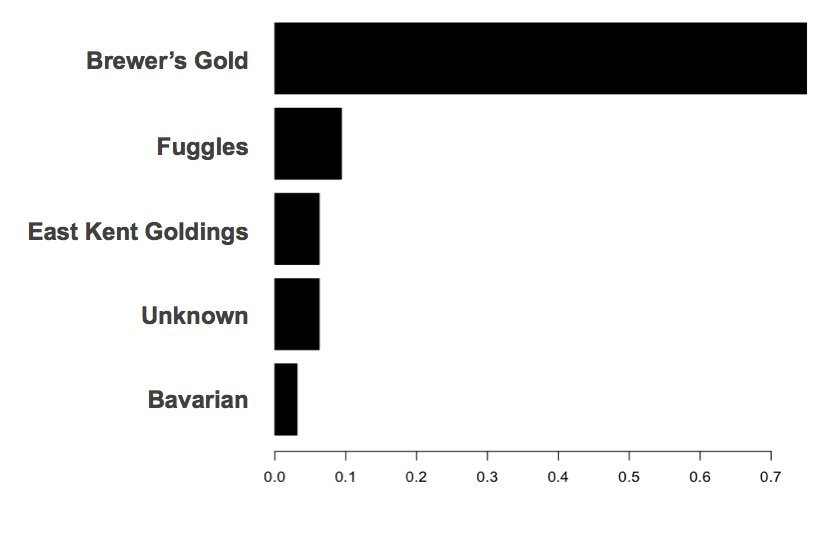Centennial

Alpha Acids (%)
9.0 - 11.0
Description
Centennial is an American hop cultivar. This dual-use variety has substantial alpha-acid content as well as a nice aroma. Centennial is often used for bittering additions. It is complimentary to many American hop varieties when used in that role.
Centennial has prominent floral and citrus flavors and aromas, which many people associate with American hop varieties. Hence, it is often grouped with other American varieties like Cascade, Chinook, and Columbus. This might be due to their somewhat similar flavors, but it could be as much due to do their alliterative names. Although, in the case of Centennial and Cascade the association is apt; both varieties share strong floral and citrus flavors. Centennial is occasionally thought of as "Super Cascade", in the sense that it tends to have significantly higher alpha-acid concentrations with highly similar flavors. Unsurprisingly, both these varieties feature myrcene as their most abundant essential oil. Centennial is frequently used in conjunction with Cascade for an extra push of bitterness.
Centennial can sometimes impart mild pine tree flavors similar to Chinook, Simcoe, and to a lesser extent Columbus. When used for bittering additions it can have a bit of an edge, producing a multi-faceted bitterness that is slightly suggestive of spiciness. When used for aroma and dry-hopping it tends more towards grassy floralness. When compared with Cascade, Centennial is often described as having less citrus flavors and more floral flavors. Centennial's citrus character may have more similarities with orange-like Amarillo than with grapefruit-like Cascade.
Possible Substitutes
For bittering applications, Columbus can produce a similarly agressive but pleasant bitterness with a citrus edge. Summit also has a strong citrus character, but with much higher alpha-acids than Centennial. Consequently, a noticably smaller amount of Summit should be used when replacing Centennial. Nugget is another possible substitute for bittering additions. It is closely related and has a similar resiny/spicy quality to its bitterness.
Amarillo, Cascade and possibly Ahtanum could all do a good job of replicating Centennial's hop aroma. Blending Cascade and Columbus in a ratio of 3 to 1 is also a popular substitute for Centennial. It follows that, blending Amarillo or Ahtanum with Columbus 3 to 1 would produce a similar mix of flavors to those in the Cascade blend.
Beer Styles
Centennial hops are one of the most used hop varieties among American craft and home brewers. Centennial is strongly associated with American IPAs. The use of Centennial is nearly de rigour for bittering additions to these highly hopped ales. Centennial are also a popular addition to American pale ales and other hoppy ale styles.
Chemical Composition
| Alpha Acids: | 9.0 - 11.0 | % |
| Beta Acids: | 3.5 - 4.5 | % |
| Alpha:Beta Ratio: | 2.5 | |
| Cohumulone: | 26 - 29 | (% alpha-acids) |
| Essential Oils: | 1.5 - 2.0 | (mL/100g) |
| Myrcene: | 50 - 60 | (% essential oils) |
| Caryophyllene: | 5 - 8 | (% essential oils) |
| Humulene: | 10 - 14 | (% essential oils) |
| Farnesene: | 0 - 1 | (% essential oils) |
All chemical composition values aggregated from [2] and [3].
Origin and Genetics
The Centennial cultivar was selected as a seedling in 1974 at the USDA hop breeding program's Prosser, Washington facility. It was released for commercial production in 1990. Centennial has similar genetics to Nugget; the two varieties share the same male parent. This is an unnamed high alpha-acid plant, and like all male hop plants it is not used directly to produce hops for beer.
Centennial's genetic pedigree is complicated but mostly known. There is only a 1/16 contribution from an unknown plant: 3/4 Brewer's Gold, 3/32 Fuggles, 1/16 East Kent Goldings, 1/16 unknown, and 1/32 Bavarian.
 |
| Figure 1: Proportion of genetic contribution from various hop varieties to Centennial's pedigree. Primarily Brewer's Gold with relatively minor contributions from other varieties. |
Centennial is thought to be well adapted to the geology and climate of the Yakima River Valley in Washington. For a long time after its introduction, it was not grown on a commercial-scale anywhere outside the state of Washington, and nearly all Centennial hops are still grown in the Yakima River Valley.
References
- "USDA Named Hop Variety Descriptions." Freshops.com. n.d. Web. 7 March 2014. ‹http://www.freshops.com/hops/usda-named-hop-variety-descriptions›.
- "Hop Varieties." Hop Union LLC. n.d. Web. 7 March 2014. ‹http://hopunion.com/hop-varieties›.
- "Yakima Chief Hop Varietal Guide." Yakima Chief Inc. n.d. Web. 7 March 2014. ‹http://yakimachief.com/index.php/varieties›.
- "USAHops Variety Manual." USAHops Inc. n.d. Web. 13 March 2014. ‹http://www.usahops.org/graphics/File/HGA%20BCI%20Reports/Variety%20Manual%207-24-12.pdf›.

